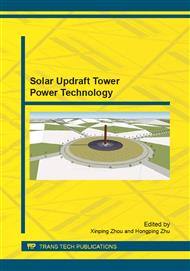p.3
p.9
p.15
p.25
p.35
p.41
p.47
p.57
Optimization of Solar Updraft Chimneys by Nonlinear Response Analysis
Abstract:
Solar updraft chimneys (SUCs) form as engines of solar updraft power plants tower-like shell structures of extreme height with rather thin shell walls, similar to high chimneys comprising multiple flue gas ducts. The height of pre-designed SUCs presently reaches up to 1000 m. Thus they are exposed chiefly to extreme wind-loads and thermal actions from the internal flow of warm air. As first design attempt, the structural analysis of solar chimneys generally is carried out by linear elastic models. For optimization, the typical shell-like wind stresses have to be constraint towards a more beam-like response behavior, approaching as far as possible linear stresses over the entire chimney circumference. This requires rather strong ring stiffeners, either as spoke-wheels in the designs of sbp (Schlaich Bergermann and Partners) or as external stiffeners in the designs of K&P (Krätzig and Partners). Both alternatives require considerable construction efforts leading to high investment costs. There exists an interesting simplification of this stiffening, namely applying to the SUC shell relatively soft external rings, and admitting large-widths cracking in the limit state of failure. This cracking constraints and equalizes the meridional stresses over the chimney’s cross-section, saving large amounts of reinforcement steel in the SUC. The design requires materially nonlinear analyses to verify the internal forces under crack-formations. The manuscript will derive this concept and demonstrate the crack analysis by example of a 750 m high solar chimney.
Info:
Periodical:
Pages:
25-34
Citation:
Online since:
January 2013
Authors:
Price:
Сopyright:
© 2013 Trans Tech Publications Ltd. All Rights Reserved
Share:
Citation:



